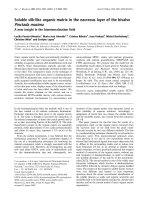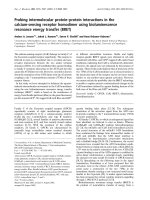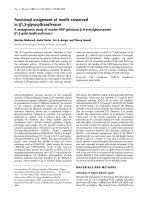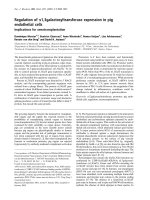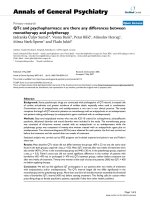Báo cáo y học: "Commentary Cyclooxygenase-2: where are we in 2003" potx
Bạn đang xem bản rút gọn của tài liệu. Xem và tải ngay bản đầy đủ của tài liệu tại đây (46.41 KB, 4 trang )
8
COX-1 = cyclooxygenase-1; COX-2 = cyclooxygenase-2; MI = myocardial infarction; NSAID = nonsteroidal anti-inflammatory agent; PGI
2
= prosta-
cyclin; TXA
2
= thromboxane A
2
.
Arthritis Research and Therapy Vol 5 No 1 Mukherjee and Topol
Introduction
Aspirin and traditional nonsteroidal anti-inflammatory
agents (NSAIDs) are effective analgesic and anti-inflam-
matory agents, but they also have significant gastrointesti-
nal toxicity. The gastrointestinal toxicity of NSAIDs is
apparently related to inhibition of the cyclooxygenase-1
(COX-1) isoform [1]. Following the discovery by Fu et al.
of a novel COX protein in monocytes stimulated by inter-
leukin [2], Kujubu et al. identified a gene with significant
homology to COX-1 [3]. Identification of this cyclooxyge-
nase-2 (COX-2) isoform resulted in the development of
selective COX-2 inhibitors, with the hope of producing a
safer analgesic and anti-inflammatory agent. The COX-2
inhibitors have generated rapid growth in the US anti-
arthritic market, with total sales exceeding $4.7 billion in
2001 and a 28% growth in year over year sales [4].
The hypothesis of the safety of COX-2 inhibitors as anti-
inflammatory agents is based on the premise that COX-1
predominates in the stomach, yielding protective
prostaglandins, while COX-2 is induced in inflammation
giving rise to pain, swelling and discomfort. It has now
been unequivocally demonstrated, however, that selective
COX-2 inhibitors also decrease vascular prostacyclin
(PGI
2
) production and may affect the homeostatic balance,
leading to a prothrombotic state [5]. By decreasing
vasodilatory and antiplatelet aggregatory PGI
2
production,
COX-2 inhibitors may tip the balance in favor of prothrom-
botic eicosanoids (thromboxane A
2
[TXA
2
]) and may lead
to increased cardiovascular thrombotic events [6].
Preclinical/molecular studies
Several basic research studies have demonstrated benefi-
cial cardiac effects of the COX-2 enzyme and potential
harmful effects of COX-2 inhibitors. Shinmura et al.
demonstrated that COX-2 mediates the cardioprotective
effects of the late phase of ischemic preconditioning [7].
By examining the late phase of ischemic preconditioning
in rabbits, they demonstrated that ischemic precondition-
ing resulted in a rapid increase in myocardial COX-2
mRNA levels. This was followed by an increase in COX-2
protein expression and in the myocardial content of
prostaglandin E
2
and 6-keto-PGF(1α) [7]. Administration
of two unrelated COX-2 selective inhibitors (NS-398 and
Selective cyclooxygenase-2 (COX-2) inhibitors were developed to reduce the gastrointestinal toxicity
of conventional nonsteroidal anti-inflammatory agents. However, COX-2 inhibitors decrease
prostacyclin production and may disrupt the normal homeostatic balance, leading to a prothrombotic
state and offsetting the potential gastrointestinal benefits. Available clinical data and basic biological
studies raise significant concern about the potential prothrombotic effect of this class of drugs. Two
recent studies with a newer, more selective COX-2 inhibitor have added to the already existing
concern about the cardiovascular safety of these agents. The widespread use of these agents
mandates prospective, randomized evaluation of the cardiovascular safety of COX-2 inhibitors.
Keywords: cardiovascular risk, cyclooxygenase-2 inhibitors, prothrombotic effects, prostaglandins
Commentary
Cyclooxygenase-2: where are we in 2003?
Cardiovascular risk and COX-2 inhibitors
Debabrata Mukherjee
1
and Eric J Topol
2
1
Division of Cardiology, University of Michigan, Ann Arbor, Michigan, USA
2
Department of Cardiovascular Medicine, The Cleveland Clinic Foundation, Cleveland, Ohio, USA
Corresponding author: Eric J Topol (e-mail: )
Received: 25 September 2002 Revisions received: 3 October 2002 Accepted: 4 October 2002 Published: 28 October 2002
Arthritis Res Ther 2003, 5:8-11 (DOI 10.1186/ar609)
© 2003 BioMed Central Ltd (Print ISSN 1478-6354; Online ISSN 1478-6362)
Abstract
9
Available online />celecoxib) 24 hours after ischemic preconditioning abol-
ished the ischemic preconditioning-induced increase in
tissue levels of prostaglandin E
2
and 6-keto-PGF(1α). The
same doses of NS-398 and celecoxib, given 24 hours
after ischemic preconditioning, completely blocked the
cardioprotective effects of late preconditioning against
both myocardial stunning and myocardial infarction (MI),
indicating that COX-2 activity is necessary for ischemic
preconditioning to occur. These results demonstrate that
upregulation of COX-2 plays an essential role in the car-
dioprotection afforded by the late phase of ischemic pre-
conditioning [7].
Hennan et al. demonstrated the important role of COX-2
in the homeostatic balance by showing that the increase in
time to vascular occlusion with aspirin in a canine coro-
nary thrombosis model was abolished with a selective
COX-2 inhibitor, celecoxib [8]. In their study of canine cir-
cumflex coronary artery thrombosis, oral high-dose aspirin
produced a significant increase in time to arterial occlu-
sion. This observed increase in time to occlusion was
abolished when celecoxib was coadministered to animals
dosed with aspirin. The study of Hennan et al. also sug-
gests the important role of COX-2-derived PGI
2
, and it
raises concerns regarding an increased risk of acute vas-
cular thrombotic events in patients receiving COX-2
inhibitors [8].
Other beneficial effects of COX-2 have also been demon-
strated in the heart. Dowd et al. demonstrated that inhibi-
tion of COX-2 aggravates doxorubicin-mediated cardiac
injury in vivo [9]. Doxorubicin induces COX-2 activity in rat
neonatal cardiomyocytes, and this expression of COX-2
limits doxorubicin-induced cardiac cell injury. Doxorubicin-
increased cardiac injury was aggravated by coadministra-
tion of SC236 (a COX-2 inhibitor) but not of SC560 (a
COX-1 inhibitor).
Cheng et al. [10] recently used an elegant transgenic
knockout mice model to further elucidate the important
physiological role of COX-2 enzyme in vascular homeosta-
sis. The investigators studied deletions of the
prostaglandin receptor to understand the effects of
COX-2 inhibitors in vivo. Mice with an absent
prostaglandin receptor (IPKO) should mimic the clinical
effect of taking COX-2 agents, as these drugs would
inhibit prostaglandin production without affecting TXA
2
.
The COX-2 knockout resulted in an enhanced proliferative
response to injury and in a significant increase in TXA
2
biosynthesis. These results suggest that PGI
2
may modu-
late the platelet–vascular interactions in vivo, and that
PGI
2
may have a beneficial effect by specifically limiting
the prothrombotic response to TXA
2
. These well-
designed, in vivo gene knockout studies raise further sig-
nificant concern about the prothrombotic effects and
cardiovascular safety of COX-2 inhibitors.
Clinical studies
Notably, clinical data with COX-2 inhibitors have also
raised concerns about cardiovascular safety [11]. There
have been two major multicenter trials with these agents,
and several smaller studies.
The Vioxx Gastrointestinal Outcomes Research Study trial,
a double-blind, randomized, stratified, parallel group study
of 8076 patients, compared the gastrointestinal toxicity of
50 mg rofecoxib daily or 1000 mg naproxen daily during
chronic treatment for patients with rheumatoid arthritis
[12]. Aspirin use was not permitted in the study. The
results of the event-free survival analysis showed that the
relative risk of developing a cardiovascular event in the
rofecoxib treatment arm was 2.37 (95% confidence inter-
val = 1.39–4.06, P = 0.0016) [13].
The Celecoxib Arthritis Safety Study was a double-blind,
randomized, controlled trial of 8059 patients. These par-
ticipants were randomized to receive either 400 mg cele-
coxib twice per day, 800 mg ibuprofen three times per day
or 75 mg diclofenac twice per day [14]. Aspirin use
(< 325 mg/day) was permitted in this study. The Celecoxib
Arthritis Safety Study trial with celecoxib demonstrated no
statistically significant difference in cardiovascular events
as compared with the NSAIDs. However, there was a
numerical excess of MI events in the celecoxib group,
regardless of whether patients were concurrently taking
aspirin. Since the trial was not powered to detect an
increase in MI, one cannot conclude that celecoxib is
exempt from prothrombotic events, especially with the
trend for more MIs.
A combined analysis of 23 phase IIb–phase V rofecoxib
studies demonstrated no evidence for an excess of cardio-
vascular events for rofecoxib relative to either placebo or
the non-naproxen NSAIDs that were studied [15].
Konstam et al., employees of the manufacturer of rofe-
coxib, concluded that differences observed between rofe-
coxib and naproxen were the result of the antiplatelet
effects of naproxen. A large cohort study by Ray et al.
[16], however, demonstrated that there was no protective
effect of naproxen on the risk of coronary heart disease
(rate ratio = 0.95, 95% confidence interval = 0.82–1.09).
Other major limitations of the analysis by Konstam et al.
[15] include combining heterogeneous patient popula-
tions receiving different dosages of the COX-2 agents.
Not a single study has considered patients with coronary
heart disease or was designed to assess cardiovascular
safety.
A second-generation, even more selective COX-2 agent,
etoricoxib, has more recently been tested in two trials
[17,18]. Although identical in design and drug dosages,
and very similar in size, the trials reported discordant find-
ings. The study by Collantes et al. [18] demonstrated no
10
Arthritis Research and Therapy Vol 5 No 1 Mukherjee and Topol
difference in efficacy between etoricoxib and naproxen in
treating patients with rheumatoid arthritis, while the study
by Matsumoto et al. demonstrated etoricoxib to be signifi-
cantly more effective [17]. More importantly, despite
excluding patients with a history of cardiovascular disease
in the form of angina, congestive heart failure, history of
MI, coronary angioplasty, coronary bypass, stroke and
transient ischemic attacks, there were two adjudicated
cardiovascular events out of 323 patients in the
Matsumoto et al. study [17], and two events out of 353
patients in the study by Collantes et al. [18]. A recent
analysis by Ray et al. of individuals on the Tennessee Med-
icaid Program demonstrated that users of high dose rofe-
coxib were 1.70 (95% confidence interval 0.98–2.95,
P = 0.058) times more likely than non users to have coro-
nary artery disease [19].
Conclusions
Seminal experimental studies, including those with knock-
out mice, have demonstrated that the COX-2 isoform pro-
duces vascular PGI
2
, which is a pivotal biologic
vasodilator and an inhibitor of platelet aggregation. Selec-
tive COX-2 inhibitors have no effect on TXA
2
production
but, by decreasing PGI
2
production, they may affect the
homeostatic balance between prothrombotic TXA
2
and
antithrombotic PGI
2
, and may lead to an increase in throm-
botic cardiovascular events [20,21].
Given the results of several large clinical trials of COX-2
inhibitors, it is clear that the theoretical concern for a pro-
thrombotic effect is now transformed to a clinical reality.
The apparent hazard does not appear to be large and, in
absolute terms, may be a fraction of 1% excess and may
be confined to patients with an as yet undefined, specific
genetic susceptibility. With such an exceptionally large
patient population at risk, however, it is imperative to
determine the precise extent of the risk and the methods
to avoid risk. In patients with atherosclerotic heart disease,
the use of low-dose aspirin in conjunction with a COX-2
inhibitor is one possible way to mitigate the risk. However,
the data from the experimental celecoxib study performed
with aspirin [8] and the clinical trial allowing aspirin [14]
have failed to offer reassurance. Furthermore, the risk of
gastrointestinal bleeding is expected to be heightened
with concurrent use of aspirin and COX-2 inhibition such
that any clinical advantage over a NSAID could be lost.
The importance of the public health issue cannot be over-
stated. The class of drugs have yet to be assessed in a
single trial of patients with known atherosclerotic disease,
who stand to be at the highest risk of adverse events. The
population of patients taking COX-2 inhibitors includes
tens of millions of individuals with such concomitant
underlying disease. Ironically, the manufacturers of the
first-generation COX-2 inhibitors spent over $265 million
in 2001 for direct-to-consumer advertising to promote
their drugs [22], but have failed to conduct a prospective
trial of COX-2 inhibitors in patients with cardiovascular
disease. We will not have advanced in any meaningful way
in 2003 unless such a trial is undertaken.
References
1. Vane JR, Botting RM: Anti-inflammatory drugs and their mech-
anism of action. Inflamm Res 1998, 47(suppl 2):S78-S87.
2. Fu JY, Masferrer JL, Seibert K, Raz A, Needleman P: The induc-
tion and suppression of prostaglandin H
2
synthase (cyclooxy-
genase) in human monocytes. J Biol Chem 1990, 265:
16737-16740.
3. Kujubu DA, Fletcher BS, Varnum BC, Lim RW, Herschman HR:
TIS10, a phorbol ester tumor promoter-inducible mRNA from
Swiss 3T3 cells, encodes a novel prostaglandin
synthase/cyclooxygenase homologue. J Biol Chem 1991,
266:12866-12872.
4. IMS Health: Reports 16.9 Percent Growth in 2001 U.S. Prescrip-
tion Sales. Westport, CT: IMS Health; 2002 [http://www.
imshealth.com/public/structure/dispcontent/1,2779,1203-1203-
144055,00.html].
5. Schmedtje JF Jr, Ji YS, Liu WL, DuBois RN, Runge MS: Hypoxia
induces cyclooxygenase-2 via the NF-kappaB p65 transcrip-
tion factor in human vascular endothelial cells. J Biol Chem
1997, 272:601-608.
6. Belton O, Byrne D, Kearney D, Leahy A, Fitzgerald DJ: Cyclooxy-
genase-1 and -2-dependent prostacyclin formation in patients
with atherosclerosis. Circulation 2000, 102:840-845.
7. Shinmura K, Tang XL, Wang Y, Xuan YT, Liu SQ, Takano H, Bhat-
nagar A, Bolli R: Cyclooxygenase-2 mediates the cardioprotec-
tive effects of the late phase of ischemic preconditioning in
conscious rabbits. Proc Natl Acad Sci USA 2000, 97:10197-
10202.
8. Hennan JK, Huang J, Barrett TD, Driscoll EM, Willens DE, Park
AM, Crofford LJ, Lucchesi BR: Effects of selective cyclooxyge-
nase-2 inhibition on vascular responses and thrombosis in
canine coronary arteries. Circulation 2001, 104:820-825.
9. Dowd NP, Scully M, Adderley SR, Cunningham AJ, Fitzgerald DJ:
Inhibition of cyclooxygenase-2 aggravates doxorubicin-medi-
ated cardiac injury in vivo. J Clin Invest 2001, 108:585-590.
10. Cheng Y, Austin SC, Rocca B, Koller BH, Coffman TM, Grosser
T, Lawson JA, FitzGerald GA: Role of prostacyclin in the cardio-
vascular response to thromboxane A
2
. Science 2002, 296:
539-541.
11. Mukherjee D, Nissen SE, Topol EJ: Risk of cardiovascular
events associated with selective COX-2 inhibitors. JAMA
2001, 286:954-959.
12. Bombardier C, Laine L, Reicin A, Shapiro D, Burgos-Vargas R,
Davis B, Day R, Ferraz MB, Hawkey CJ, Hochberg MC, Kvien TK,
Schnitzer TJ: Comparison of upper gastrointestinal toxicity of
rofecoxib and naproxen in patients with rheumatoid arthritis.
VIGOR Study Group. N Engl J Med 2000, 343:1520-1528.
13. Food and Drug Administration: Cardiovascular Safety Review of
Rofecoxib. Gaithersburg, MD: FDA Advisory Committee; 2001
[ />ardio.pdf].
14. Silverstein FE, Faich G, Goldstein JL, Simon LS, Pincus T,
Whelton A, Makuch R, Eisen G, Agrawal NM, Stenson WF, Burr
AM, Zhao WW, Kent JD, Lefkowith JB, Verburg KM, Geis GS:
Gastrointestinal toxicity with celecoxib vs nonsteroidal anti-
inflammatory drugs for osteoarthritis and rheumatoid arthri-
tis: the CLASS study: a randomized controlled trial. Celecoxib
Long-Term Arthritis Safety Study. JAMA 2000, 284:1247-
1255.
15. Konstam MA, Weir MR, Reicin A, Shapiro D, Sperling RS, Barr E,
Gertz BJ: Cardiovascular thrombotic events in controlled, clini-
cal trials of rofecoxib. Circulation 2001, 104:2280-2288.
16. Ray WA, Stein CM, Hall K, Daugherty JR, Griffin MR: Non-
steroidal anti-inflammatory drugs and risk of serious coronary
heart disease: an observational cohort study. Lancet 2002,
359:118-123.
17. Matsumoto AK, Melian A, Mandel DR, McIlwain HH, Borenstein D,
Zhao PL, Lines CR, Gertz BJ, Curtis S: A randomized, con-
trolled, clinical trial of etoricoxib in the treatment of rheuma-
toid arthritis. J Rheumatol 2002, 29:1623-1630.
11
18. Collantes E, Curtis SP, Lee KW, Casas N, McCarthy T, Melian A,
Zhao PL, Rodgers DB, McCormick CL, Lee M, Lines CR, Gertz
BJ: A multinational randomized, controlled, clinical trial of
etoricoxib in the treatment of rheumatoid arthritis. BMC
Family Pract 2002, 3:1-10.
19. Ray W, Stein C, Daugherty J, Hall K, Arbogast P, Griffin M:
COX-2 selective non-steroidal anti-inflammatory drugs and
risk of serious coronary heart disease. Lancet 2002, 360:
1071-1073.
20. McAdam BF, Catella-Lawson F, Mardini IA, Kapoor S, Lawson JA,
FitzGerald GA: Systemic biosynthesis of prostacyclin by
cyclooxygenase (COX)-2: the human pharmacology of a
selective inhibitor of COX-2. Proc Natl Acad Sci USA 1999, 96:
272-277.
21. Catella-Lawson F, McAdam B, Morrison BW, Kapoor S, Kujubu D,
Antes L, Lasseter KC, Quan H, Gertz BJ, FitzGerald GA: Effects
of specific inhibition of cyclooxygenase-2 on sodium balance,
hemodynamics, and vasoactive eicosanoids. J Pharmacol Exp
Ther 1999, 289:735-741.
22. Burton TM: Reigning in drug advertising, backlash rises
against flashy ads for prescription pharmaceuticals. Wall
Street Journal 13 March 2002 [ />0,,SB1015968026351450840.djm,00.html].
Correspondence
Eric J Topol, Provost and Chief Academic Officer, Chairman, Depart-
ment of Cardiovascular Medicine, The Cleveland Clinic Foundation,
F 25, 9500 Euclid Avenue, Cleveland, OH 44195, USA. Tel: +1 216
445 9493; fax: +1 216 445 9595; e-mail:
Available online />


